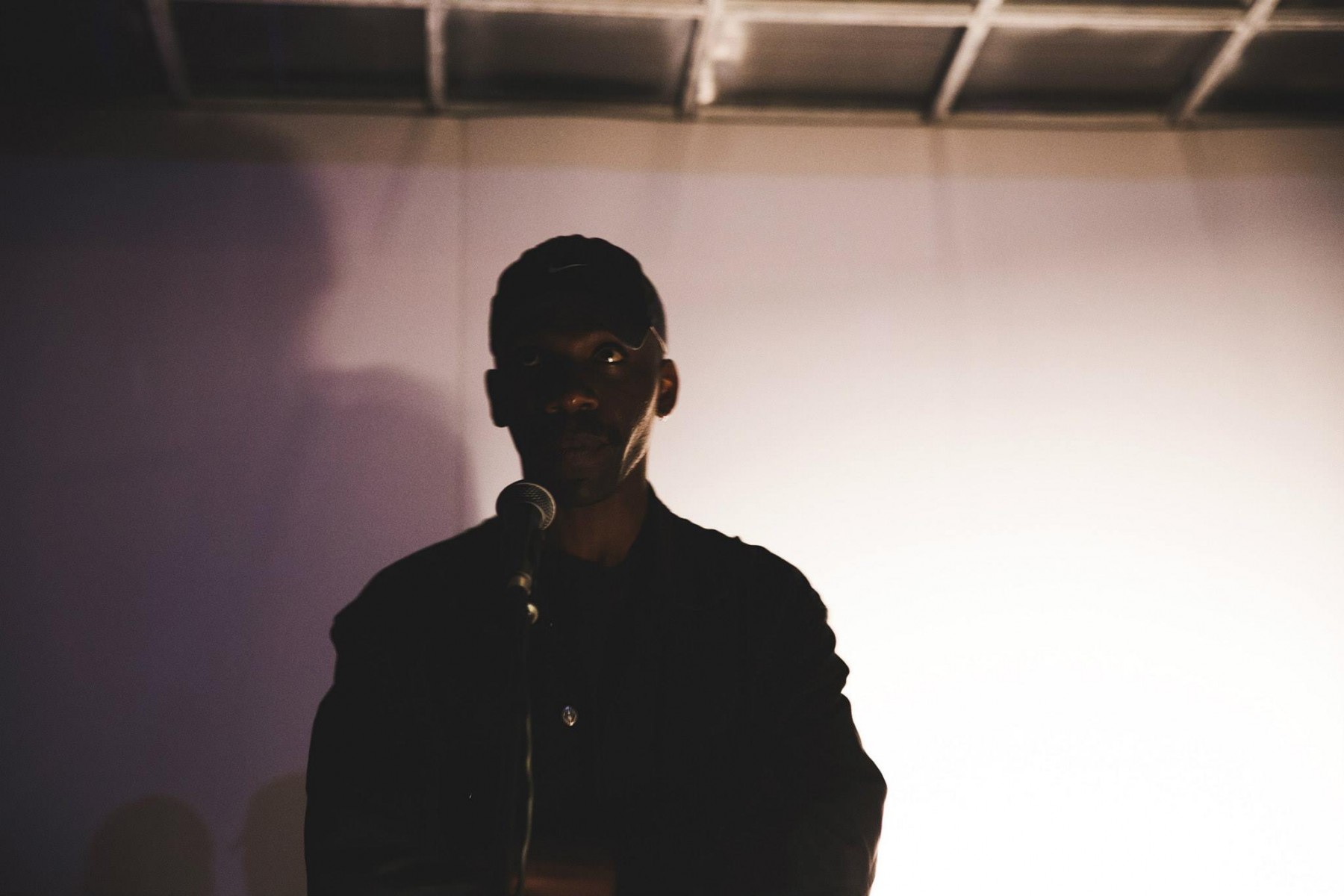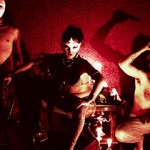The Redeemer: The presence of Dean Blunt

One of the most intriguing performances of 2013 refused to be either a concert or performance art, and we didn’t see it live. It involved a microphone, a spotlight and a music track. Dean Blunt’s July 19th performance at Artists Space in New York — and viewable on YouTube — was a radical redefinition of what constituted a live performance. Preceded by more than 10 minutes of white noise (possibly the sound of rain or a train) in a pitch black gallery, the show “kicked off,” if you will, with a loud synth melody as the light slowly rose unveiling a mic stand on a small platform, Blunt pacing, and another man in a suit standing arms-crossed a few feet back.
As the melody played, Blunt eventually approached the mic and the beginning chords of “The Pedigree” from his album The Redeemer began. As the music for “Dread” began, an answering machine message played with a recording of a woman’s voice: “It’s me…look, can you stop calling me…”
There was no band, no instruments, just Blunt, with a black baseball cap tugged low to cover his downcast eyes, pacing and fidgeting, listening to the music with the audience between vocal parts. A commenter on YouTube joked, “The artist is present.” But in a sense beyond the obvious reference, presence is indeed what Blunt offers. The performance lacked nearly all the trappings of what is expected of a concert, feeling instead confessional, simultaneously less and more live.
Blunt’s strange performance befits his 2013 album The Redeemer (and the free, recorded-in-Russia follow-up Stone Island). Inventively appropriative yet deeply affecting, The Redeemer presents a new model of “the personal record.” On “The Pedigree,” over strings, Blunt’s voice quietly, plaintively sings, “For me to get to know you better… there’s something I should let you know. To me you’re just another lady…” (a simple drum pattern starts) “You’re gonna have to let me go.” The album outlines a failed relationship and its aftermath.

The album’s string intro, titled “I Run New York” feels cinematic and heartfelt, but a little digging reveals the track is lifted, unaltered, from the beginning of K-Ci & JoJo’s “All My Life,” a saccharine R&B song from 1998. The angrily yelled “What’m I do now? Huh? It’s all fucked up now,” occurring midway through the title track is from an odd outburst in a Puff Daddy song; in the original, it seems artificial and tacked on, in “The Redeemer” the same phrase reads as intense, brutally honest expression. The cut-and-paste make-up of the album risks clouding the reading of the music; Nick Neyland in Pitchfork hedges, “Dean Blunt is heartbroken, possibly.”
The Redeemer is unlike Blunt’s previous work under the name Hype Williams. Gone or subdued are the connections between the productions and those of the electronic music scene (though the album still finds itself filed with electronic dance music or EDM). In their place: an expanded vocabulary of live-sounding instruments and pop song form.
Dean Blunt is in all likelihood not his name; his frequent collaborator Inga Copeland’s name might also be pseudonymic. Together they made the majority of their work as Hype Williams (releasing a last album together under their ‘names’). Doubly a readymade, it is also the name of director Hype Williams, best known for bombastic and big budgeted music videos for Missy Elliot, Busta Rhymes and R. Kelly. Allegedly, the Hype Williams project was passed to Blunt and Copeland and they left the name intact. There is a nice parallel between this origin story and a lyric by UK rapper Trim on a Blackdown Productions track: “It was said, that this was not the world I was born into, I fell from the sky and I was found and kept.” Their moniker made cursory internet searching near impossible; coupled with their aversion to the press, the sense of mystery was exacerbated. In the few interviews they did grant it is hard to distinguish fact from fiction. From an interview in the Guardian, April 5, 2012:
Blunt finishes by saying Copeland is going to Detroit to become a “speed racer” while his plan is to go to wrestling school. Then a couple of days after our interview I get an email apologizing for not explaining how he and Copeland met: “knebworth.oasis,day one. ’96. heard some offkey russian accent singing the wrong words to acquiesce …disagreed over how i thought ‘cast no shadow’ meant the same as ‘get the wogs out’. she hung around.”
That the two may (or may not) have met over a language-based disagreement at an Oasis concert seems apt. Together, over the course of four albums, they created beguiling, strange, genre defying (and defining) songs. Ghostly, home recorded, blurry music that has found a place among the adventurous strains of electronic and indie music. Skill is displaced from traditional instrument mastery and compositional craftsmanship to the expression of an ear open to sounds both found and made. Operating solo, Blunt’s The Redeemer, which came out after a pair of short EPs titled The Narcisist I & II, has small sonic moments that might read as affectations; but these are what tie the complex, ramshackle whole together. David Stubbs says in Resident Advisor, “Such interventions, like the coughing fit that concludes ‘Brutal,’ are vital in the fabric of The Redeemer, which feels part art installation, part cri de coeur, but all true—further reason to believe the Hype.”
Compiled of interwoven samples, The Redeemer’s appropriated materials unite like a grafted tree; The Redeemer is made of both its constituent elements and how they got there. In a sense, it is a combination of pastiche and bricolage infused with the artist’s experience as simply another, potentially recognizable piece. The Redeemer is not simply an album of deftly culled samples, distanced by time and place. Rather the album is wildly personal and affecting. The wish to be friends post break up, the power of a relationship to instigate reformation or betterment of character, the melancholy induced by the gap between an uncertain present and a foreclosed intoxicating love lost; from Blunt’s vocabulary of sonic and pop cultural memory these familiar feelings are given a specific expression.
That this vocabulary is personal is key; this is Blunt’s translation of what has happened in his relationship in a musical language. In turn, the album’s peculiar makeup is an elucidation/condensation of the musical scenes through which Blunt has traveled through his life, both the aesthetic characteristics of the many genres and their particular forms of address. The lyrics recall R&B and folk music, but also how more aggressive genres deal with the political or personal through direct language clouded by volume. It is a cohesive, if roughshod whole. There is rawness to the production throughout, and with a quick “no new messages” recording, the album ends.
Responding to the question of whether the rough, demo-like haze on one of his albums bore any resemblance to what might be considered similar sounding music from California, Blunt responded, “…I don’t hear that, I hear smoking weed and playing Playstation, and going to the Trocadero, you know. Walking around Tottenham, Broadwater Farm at night and that stuff. I don’t hear ‘beach’ and ‘LA’ because I haven’t been to LA.” Song or genre tropes are incorporated out of any traditional context, and regardless of the artist’s ability to execute musically in a traditionally virtuosic manner. It is music where anything goes at the service of the work’s desired effect.
Any attempts at brutal, direct honesty are instantly entangled in the performance and management of identity now so commonplace; the means of offering to an audience a sort of radical sincerity, once the purview of the performance artist, are now widely dispersed, commonplace, and mundane. Blunt places an emphasis on his work being received at face value. “People wonder why nothing is interesting, it’s because they try to get a fucking answer to it, to everything.” Blunt’s practice creates truth precisely by barring or complicating aspects of its inner workings.
In a video on his Youtube page titled “Casting call – Syreeta,” a woman reads from a script by Blunt; through poetic language something true emerges: “I ask, I believe, I receive (…) I walk away from that old desperate and dazed love, caught up in the maze of love, the crazy, crazy maze of love… thought it was good, thought it was real, thought it was…”
* A portion of this article was previously published in San Francisco Arts Quarterly
You might also like:




